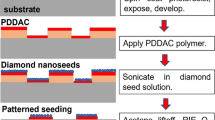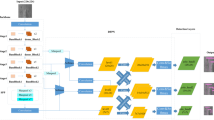Abstract
Glass Passivation Parts (GPP) wafer texture defects are one of the most important factors affecting the accuracy of wafer defect detection. Template matching has local errors and low efficiency, and deep learning requires many training samples. In the early stage, defect training sample sets cannot be provided. This paper discusses the design of an effective GPP wafer grain region texture defect detection algorithm using a sub-region one-to-one mapping. A set of standard wafer datum is selected as the reference of grain region segmentation detection, and then the standard wafer images and test GPP wafer images are automatically calibrated and segmented, respectively. Then, a series of pre-processes were performed to equalize the sizes of the two grain-region images. Then the grain region was divided into an equal number of rectangular sub-regions of the same size according to the measurement precision requirement. The correlation degree of each test sub-region is judged by the designed three-channel RGB gray-scale similarity decision functions. Experiments show that the algorithm successfully achieved the necessary calibration and segmentation for the grain region. Compared with the template and histogram matching algorithms, the proposed method does not require a training set, the detection accuracy is significantly improved and the detection efficiency is up to 29.74 times better on average using the proposed algorithm.












Similar content being viewed by others
References
Bretzner L, Laptev I, Lindeberg T (2002) Hand gesture recognition using multi-scale colour features, hierarchical models and particle filtering[C]//Automatic Face and Gesture Recognition, 2002. Proceedings. Fifth IEEE International Conference on. IEEE, pp 423–428
Cuche E, Marquet P, Depeursinge C (2000) Spatial filtering for zero-order and twin-image elimination in digital off-axis holography[J]. Appl Opt 39(23):4070–4075
Dabov K, Foi A, Katkovnik V, Egiazarian K (2007) Image denoising by sparse 3-D transform-domain collaborative filtering [J]. IEEE Trans Image Process 16(8):2080–2095
Jian C, Gao J, Ao Y (2017) Automatic surface defect detection for mobile phone screen glass based on machine vision [J]. Appl Soft Comput 52:348–358
Kass M, Witkin A, Terzopoulos D (1988) Snakes: active contour models [J]. Int J Comput Vis 1(4):321–331
Kim D, Kang P, Cho S, Lee HJ, Doh S (2012) Machine learning-based novelty detection for faulty wafer detection in semiconductor manufacturing[J]. Expert Syst Appl 39(4):4075–4083
Kim JS, Jang SJ, Kim TW et al (2018) A productivity-oriented wafer map optimization using yield model based on machine learning[J]. IEEE Trans Semicond Manuf 32(1):39–47
Krizhevsky A, Sutskever I, Hinton GE (2012) Imagenet classification with deep convolutional neural networks[C]//Advances in neural information processing systems, pp 1097–1105
Lin YH, Chen CH (2008) Template matching using the parametric template vector with translation, rotation and scale invariance [J]. Pattern Recogn 41(7):2413–2421
Loce R P, Cuciurean-Zapan C (n.d.) Loose gray-scale template matching for image processing of anti-aliased lines: U.S. Patent 6,944,341[P]. 2005-9-13
Lowe DG (2004) Distinctive image features from scale-invariant keypoints [J]. Int J Comput Vis 60(2):91–110
Manjunath BS, Ma WY (1996) Texture features for browsing and retrieval of image data [J]. IEEE Trans Pattern Anal Mach Intell 18(8):837–842
Meli L, Bonam R, Halle S, Felix N (2017) Detection of printable EUV mask absorber defects and defect adders by full chip optical inspection of EUV patterned wafers [J]. IEEE Trans Semicond Manuf 30(4):402–409
Meli L, Petrillo K, De Silva A et al (2017) Driving down defect density in composite EUV patterning film stacks[C]//extreme ultraviolet (EUV) lithography VIII. International Society for Optics and Photonics, 10143: 101430Y
See J E, Drury C G, Speed A et al (2017) The role of visual inspection in the 21st century[C]. Proceedings of the human factors and ergonomics society annual meeting. Sage CA: Los Angeles, CA: SAGE Publications, 61(1): 262–266
Smit RJM, Brekelmans WAM, Meijer HEH (1998) Prediction of the mechanical behavior of nonlinear heterogeneous systems by multi-level finite element modeling[J]. Comput Methods Appl Mech Eng 155(1–2):181–192
Tanimoto SL (1981) Template matching in pyramids [J]. Comput Graph Image Process 16(4):356–369
Tello G, Al-Jarrah OY, Yoo PD et al (2018) Deep-structured machine learning model for the recognition of mixed-defect patterns in semiconductor fabrication processes[J]. IEEE Trans Semicond Manuf 31(2):315–322
Tsai DM, Huang CK (2018) Defect detection in electronic surfaces using template-based Fourier image reconstruction[J]. IEEE Trans Compon Packag Manuf Technol 9(1):163–172
Wang MJJ, Huang CL (2004) Evaluating the eye fatigue problem in wafer inspection [J]. IEEE Trans Semicond Manuf 17(3):444–447
Yong P B, Simon G, Du Y (n.d.) Generating a wafer inspection process using bit failures and virtual inspection: U.S. Patent Application 10/014,229[P]. 2018-7-3
Zhong F, He S, Li B (2017) Blob analyzation-based template matching algorithm for LED chip localization [J]. Int J Adv Manuf Technol 93(1):55–63
Zhu XX, Bamler R (2013) A sparse image fusion algorithm with application to pan-sharpening [J]. IEEE Trans Geosci Remote Sens 51(5):2827–2836
Acknowledgements
this paper was supported by the National Key R&D Program of China (2017YFB1301203), National Natural Science Foundation of China (51775492), the Key R&D Program of Zhejiang Province (No. 2020C01026), and Robotics Institute of Zhejiang University (No. K11808 and K11811).
Author information
Authors and Affiliations
Corresponding author
Additional information
Publisher’s note
Springer Nature remains neutral with regard to jurisdictional claims in published maps and institutional affiliations.
Rights and permissions
About this article
Cite this article
Wang, J., Yu, Z., Duan, Z. et al. A sub-region one-to-one mapping (SOM) detection algorithm for glass passivation parts wafer surface low-contrast texture defects. Multimed Tools Appl 80, 28879–28896 (2021). https://doi.org/10.1007/s11042-021-11084-8
Received:
Revised:
Accepted:
Published:
Issue Date:
DOI: https://doi.org/10.1007/s11042-021-11084-8




